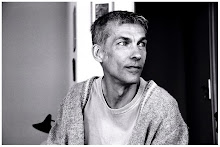The first thing that struck me as I entered the MEET apartment in Saint-Nazaire was the light. Tender, but with a presence that is almost physical, like in a painting by the Danish light painter Vilhelm Hammershøi. The light comes from three directions, falls in through large windows and creates a spacious lightness and comfort in the four rooms. It was one of the first days in November 2007, and I had – only one day earlier – left my small one room apartment in Stockholm where the late autumn darkness was enclosing the city and my home, and the daylight only lasted for a few hours. The difference was enormous and also very pleasant.
The second impression was the size of the apartment – to be able to walk from one room to another, and to be able to choose where I should sit and work. Whenever I wanted I could get up from the chair, enter another room or go out on one of the two balconies to look out over the Loire River reaching the Atlantic.
I sent a few photographs of the apartment and the view to a friend, the Estonian writer Tõnu Õnnepalu. His reply was immediate. “What a wonderful light! What a marvellous view! I remember the spring-like light of France in November and December very well!”
Underneath the eastern balcony lies the lock. Several times a day a bell announces the lifting of the bridge; a ship is coming in to – or leaving – the harbour. It’s a constant stimulation for my thoughts. Where will it sail? What is the cargo?
The MEET apartment has hosted several writers and translators from all over the world through out the years. All visitors have left more or less obvious impressions. Here and there in the apartment there are books by some of the visitors, Giuseppe Conte, Juan Carlos Mondragon, Peter Laugesen… Some of the books are part of MEET:s bilingual book series, and several of the writers have been inspired by the place and written about Saint-Nazaire, le Building, the view and the apartment. Sometimes I can feel their presence, I think I see for example Gabriela Adamesteanu sitting in the sofa studying the pages she’s been writing during the day, or I see a poet from Angola making tea in the kitchen while thinking about a certain phrase in the poem he’s writing.
Outside the window where my desk is standing, I see the crane operator climbing up to work – just like my father used to do everyday in another harbour town far away from here when I was a child – high above the houses on Le Maroc; we work on the same level, the crane operator and me, and we both share this ever changing but always very exciting view of the city, the river, the harbour and the sea.
The boom of the crane is very long, perhaps fifty meters. The work we create during our stay in the MEET apartment – me and the other writers and translators – reach even further. Some travel out in the world, starting with a note or an idea in let’s say Islington in London, or Schöneberg in Berlin, which then is clad in a new language cloth and read by people in Santiago, Epeigné les Bois or Kyoto. It’s a dizzying thought, also very tempting – all those stories which come through in the meeting with the reader.
So, Le Maroc is on the other side of the lifting bridge. One rainy day in November – during MEET:s annual literary festival – I was walking around in Saint-Nazaire with the poet Yang Lian.
“Isn’t it fantastic, Håkan? Here we are in a small French town, you from Sweden, and me – born in a Swiss town by Chinese parents, and after years of travelling now living in London. We speak English with each other. We pass a monstrous German building, and we’re heading for Africa! Le Maroc! The world really is wonderful!”
The German building is of course the Base Sous-marine. One translator said it reminded her of a pyramid. A gigantic historical colossus with its own aesthetics. The aged concrete bear more or less clear remains from letters and figures that once had a meaning. Here and there the rusty reinforcement bars come through – glittering like jewellery when the sun reaches them. An enormous building from a terrible time. The ideology that created it will hopefully soon die away. But the building will continue its struggle against time, wind and rain. Maybe it will be just as old as the pyramids are today. Maybe future archaeologists will find traces from one of the literary festivals while exploring the building, and they will try to decipher the traces – in Japanese, Persian, French, Norwegian… Maybe they will also find a bewildering fragment from a Portuguese play: “Time is man’s greatest invention.”
It’s very nice to live and work here in the MEET apartment. It’s on the 10th floor, providing both the fantastic views and a kind of isolation. Like being in a light house. All the factors of this place – the light, the space, the view and the isolation – create the working base I and many other writers and translators long for. Between working hours I go for long walks in the harbour, on the piers, in the botanical garden or along the sandy Atlantic beach. There is a ship out there. In an hour or so the bell will toll and the bridge will open once again. I have plenty of time to walk back to Le Building, take the elevator to the 10th floor, make a cup of coffee and sit down on the balcony before the ship comes in. Yet another ship. Yet another story. And I will finish my coffee, return to my desk to write it down.
Håkan Lindquist, Saint-Nazaire, January 2008.







Inga kommentarer:
Skicka en kommentar